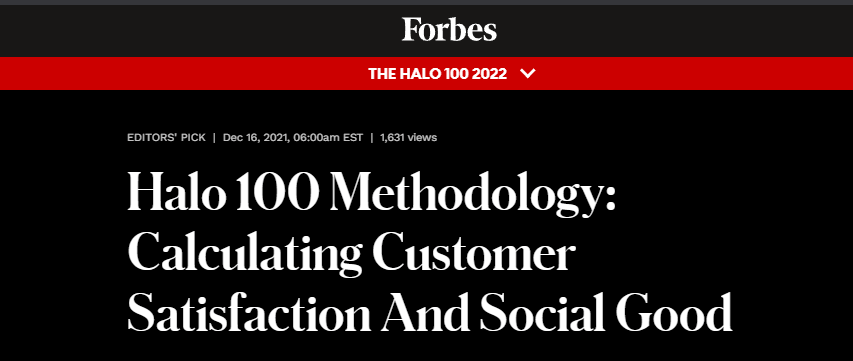HundredX Methodology Used for Halo 100
This article first appeared in Forbes Online as part of the Forbes Halo 100 list.
In a world that’s under pressure, it’s no longer enough to judge a brand by the delight it sparks in those who use it. We want to understand its impact on different groups of customers and the degree to which that brand has earned their trust. In other words, who best meets the needs of all U.S. customers, responsibly?
That’s why we partnered with HundredX on the inaugural Forbes Halo 100 list. The Dallas-based insights and analytics company has developed an innovative way to collect customer-experience feedback: Participants select up to 75 brands they use from more than 2,000 options across 75 different consumer-facing industries. Unlike surveys that ask a customer to either validate or disagree with a range of statements, this format allows people to select companies they know and then report on what matters to them — and why. It could be quality, convenience, speed, trust or some other factors. In return for getting feedback, HundredX makes a payment for each survey to one of more than 200 charities and causes.
As HundredX founder Rob Pace explains, the goal is to measure the outcomes that brands are actually creating for their customers. “My conclusion was that if we could create the ability to truly listen and get unfiltered data from consumers, that would be a game changer,” says Pace.
The list is calculated using aggregated and anonymized double-blind data provided by some 110,000 customers on more than 2.8 million experiences they’ve had with the brands they chose during the past year. That data is used to create three sub-categories: All Customer Satisfaction, Customers of Color Satisfaction, and Brand Values/Trust. “Customers of Color” include those who have self-identified as being members of eight different race/ethnicity groups other than White/Caucasian.
To Read the Full Article, Click Here.
Did your Company Make the Halo 100 List?
Would You Like to Learn More about the Data We Gathered for Your Company?
Learn more about HundredX and our solutions by requesting a demo.
Strategy Made Smarter
HundredX works with a variety of companies and their investors to answer some of the most important strategy questions in business:
- Where are customers "migrating"?
- What are they saying they will use more of in the next 12 months?
- What are the key drivers of their purchase decisions and financial outcomes?
Current clients see immediate benefits across multiple areas including strategy, finance, operations, pricing, investing, and marketing.
Our insights enable business leaders to define and identify specific drivers and decisions enabling them to grow their market share.
Please contact our team to learn more about which businesses across 75 industries are best positioned with customers and the decisions you can make to grow your brand’s market share.




